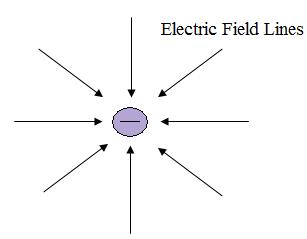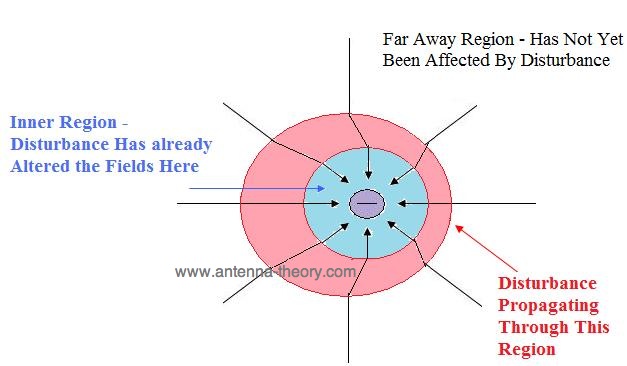Why do Antennas Radiate?
Obtaining an intuitive idea for why antennas radiate is helpful in understanding the fundamentals of antennas. On this page, I'll attempt to give a low-key explanation with no regard to mathematics on how and why antennas radiate electromagnetic fields.
First, let's start with some basic physics. There is electric charge - this is a quantity of nature (like mass or weight or density) that every object possesses. You and I are most likely electrically neutral - we don't have a net charge that is positive or negative. There exists in every atom in the universe particles that contain positive and negative charge (protons and electrons, respectively). Some materials (like metals) that are very electrically conductive have loosely bound electrons. Hence, when a voltage is applied across a metal, the electrons travel around a circuit - this flow of electrons is electric current (measured in Amps).
Let us get back to charge for a moment. Suppose that for some reason, there is a negatively charged particle sitting somewhere in space. The universe has decided, for unknown reasons, that all charged particles will have an associated electric field with them. This is illustrated in Figure 1.

Figure 1. A negative charge has an associated Electric Field with it, everywhere in space.
So this negatively charged particle produces an electric field around it, everywhere in space. The Electric Field is a vector quantity - it has a magnitude (how strong the field strength is) and a direction (which direction does the field point). The field strength dies off (becomes smaller in magnitude) as you move away from the charge. Further, the magnitude of the E-field depends on how much charge exists. If the charge is positive, the E-field lines point away from the charge.
So this negatively charged particle produces an electric field around it, everywhere in space. The Electric Field is a vector quantity - it has a magnitude (how strong the field strength is) and a direction (which direction does the field point). The field strength dies off (becomes smaller in magnitude) as you move away from the charge. Further, the magnitude of the E-field depends on how much charge exists. If the charge is positive, the E-field lines point away from the charge.
The universe has also decided (again, for no apparent reason) that disturbances due to moving (or accelerating) charges will propagate away from the charge at the speed of light - c0 = 300,000,000 meters/second. This means the electric fields around the charge will be disturbed, and this disturbance propagates away from the charge. This is illustrated in Figure 2.

Figure 2. The E-fields when the charge is accelerated.
Once the charge is accelerated, the fields need to re-align themselves. Remember, the fields want to surround the charge exactly as they did in Figure 1. However, the fields can only respond to events at the speed of light. Hence, if a point is very far away from the charge, it will take time for the disturbance (or change in electric fields) to propagate to the point. This is illustrated in Figure 2.
In Figure 2, we have 3 regions. In the light blue (inner) region, the fields close to the charge have readapted themselves and now line up as they do in Figure 1. In the white region (outermost), the fields are still undisturbed and have the same magnitude and direction as they would if the charge had not moved. In the pink region, the fields are changing - from their old magnitude and direction to their new magnitude and direction.
Hence, we have arrived at the fundamental reason for radiation - the fields change because charges are accelerated. The fields always try to align themselves as in Figure 1 around charges. If we can produce a moving set of charges (this is simply electric current), then we will have radiation.
Now, you may have some questions.
First - if all accelerating electric charges radiate, then the wires that connect my computer to the wall should be antennas, correct? The charges on them are oscillating at 60 Hertz as the current travels so this should yield radiation, correct?
Answer: Yes. Your wires do act as antennas. However, they are very poor antennas. The reason (among other things), is that the wires that carry power to your computer are a transmission line - they carry current to your computer (which travels to one of your battery's terminals and out the other terminal) and then they carry the current away from your computer (all current travels in a circuit or loop). Hence, the radiation from one wire is cancelled by the current flowing in the adjacent wire (that is travelling the opposite direction).
Another question that will arise is - if its so simple, then everything could be an antenna. Why don't I just use a metal paper clip as an antenna, hook it up to my receiver and then forget all about antenna theory?
Answer: A paper clip could definitely act as an antenna if you get current flowing on the antenna. However, it is not so simple to do this. The impedance of the paper clip will control how much power your receiver or transmitter could deliver to the paper clip (i.e. whether or not you could get any current flowing on the paper clip at all). The impedance will depend on what frequency you are operating at. Hence, the paper clip will work at certain frequencies as an antenna. However, you will have to know much more about antennas before you can say when and it may work in a given situation.
--------------
In summary, all radiation is caused by accelerating charges which produce changing electric fields. And due to Maxwell's Equations, changing electric fields give rise to changing magnetic fields, and hence we have electromagnetic radiation. The subject of antenna theory is concerned with transferring power from your receiver (the energy is contained in voltages and currents) into electromagnetic radiation (where the energy is contained in the E- and H-fields) travelling away from the antenna. This requires the impedance of your antenna to be roughly matched to your receiver, and that the currents that cause radiation add up in-phase (that is, they don't cancel each other out as they would in a transmission line). A multitude of antenna types produce ways of achieving this, and you can find descriptions about them on the antenna list page.
来源:http://www.antenna-theory.com/basics/whyantennasradiate.php
Why do Antennas Radiate?的更多相关文章
- 扫描线 - UVALive - 6864 Strange Antennas
Strange Antennas Problem's Link: http://acm.hust.edu.cn/vjudge/problem/viewProblem.action?id=87213 M ...
- UVALive - 6864 Strange Antennas 扫描线
题目链接: http://acm.hust.edu.cn/vjudge/problem/87213 Strange Antennas Time Limit: 3000MS 题意 一个雷达能够辐射到的范 ...
- AT3912 Antennas on Tree
AT3912 Antennas on Tree %%zzt 只能考虑性质了. 把最后选择的k个点的连通块求出来,连通块内部的点表示都是互异的 连通块外部的点只能形成若干条链,并且这k个点的每一个最多与 ...
- uvalive6468,51cthink1419 Strange Antennas (离散化)
题意: 在一个 n x n 的平面上,给定 m 个等腰直角三角形(各点均为整数),问该平面上被三角形覆盖奇数次的点有多少个. 思路: 由于 n 较大,不能模拟解决,故使用离散化思想. 考虑每一行有多少 ...
- Radio Basics for RFID
Radio Basics for RFID The following is excerpted from Chapter 3: Radio Basics for UHF RFID from the ...
- RFID 基础/分类/编码/调制/传输
不同频段的RFID产品会有不同的特性,本文详细介绍了无源的感应器在不同工作频率产品的特性以及主要的应用. 目前定义RFID产品的工作频率有低频.高频和甚高频的频率范围内的符合不同标准的不同的产品,而且 ...
- Half Wavelength Dipole Antenna
Reference : 1. wikipedia The dipole antenna is the simplest and most widely used class of antenna.It ...
- IFA Basics
The inverted-F antenna is shown in Figure 1. While this antenna appears to be a wire antenna, after ...
- linux查看端口及端口详解
今天现场查看了TCP端口的占用情况,如下图 红色部分是IP,现场那边问我是不是我的程序占用了tcp的链接,,我远程登陆现场查看了一下,这种类型的tcp链接占用了400多个,,后边查了一下资料,说E ...
随机推荐
- [BZOJ 1855] 股票交易
Link: BZOJ 1855 传送门 Solution: 比较明显的$dp$模型 令$dp[i][j]$为第$i$天持有$j$支股票时的最大利润 对其购买股票和售出股票分别$dp$,这里以购买为例: ...
- 【贪心】【堆】bzoj2590 [Usaco2012 Feb]Cow Coupons
每个物品有属性a,b 考虑在仅仅用光优惠券时的最优方案. 显然是按照b排序,取前K个. 但是我们还要尽可能去取剩余的. 假设朴素地取剩余的话,应该把剩余的对a排序,然后尽量去取. 但是有可能对其用优惠 ...
- 【转载】Java中String类的方法及说明
转载自:http://www.cnblogs.com/YSO1983/archive/2009/12/07/1618564.html String : 字符串类型 一. String sc_ ...
- Springcloud中的region和zone的使用
一.背景 用户量比较大或者用户地理位置分布范围很广的项目,一般都会有多个机房.这个时候如果上线springCloud服务的话,我们希望一个机房内的服务优先调用同一个机房内的服务 ,当同一个机房的服务不 ...
- [转]currentStyle和getComputedStyle的兼容写法
currentStyle:获取计算后的样式,也叫当前样式.最终样式. 优点:可以获取元素的最终样式,包括浏览器的默认值,而不像style只能获取行间样式,所以更常用到. 注意:不能获取复合样式如bac ...
- Android 权限处理
概述: 为了保护系统的完整性和用户隐私权,Android 在访问受限的沙盒中运行每款应用. 如果应用需要使用其沙盒以外的资源或信息,则必须明确请求权限. 根据应用请求的权限类型,系统可能会自动授予权限 ...
- Linux PHP 编译参数详解(二)
对于喜欢玩开源软件的童鞋么,都喜欢自己编译安装程序,本文说明下如何编译安装php的详细参数. 示例: ./configure \ --prefix=/usr/local/php --with-zlib ...
- [转] Moran's I
李旭, Matlab: Moran's I原文地址 Introduction In statistics, Moran's I is a measure of spatial autocorrelat ...
- 【redis】在spring boot2.0中使用redis的StringRedisTemplate 自动注入@Autowired
1.使用opv.increment 达到增量的效果[判断某个用户 是第几次做这种操作] @RequestMapping("createCode") @RestController ...
- NPD南京炮苑电子技术研究所----NPD治疗仪
NPD南京炮苑电子技术研究所有限公司: http://www.npd365.com/ 研发药物离子导入和中医定向透药技术. 南京炮苑玉古康2号NPD系列专用中医定向透药治疗仪腰颈椎疼痛贴 N ...
